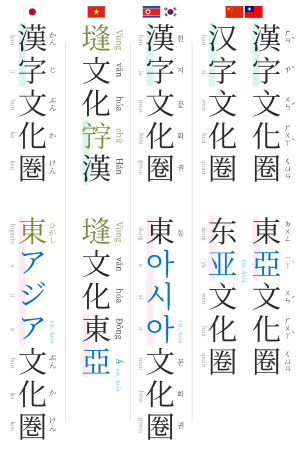CJK characters facts for kids
When we talk about making computers and software work for people all over the world, we often use the term CJK. This is a short way to say Chinese, Japanese, and Korean languages. These languages are grouped because they all use, or used to use, Chinese characters in their writing systems. Sometimes, Vietnamese is also included, making it CJKV, because Vietnamese also historically used Chinese characters. These characters are known by different names in each language, like hànzì in Chinese, kanji in Japanese, hanja in Korean, and hán tự or chữ nôm in Vietnamese.
Contents
East Asian Languages: CJKV
The CJKV group represents some of the most spoken languages in the world. They are important in technology, business, and culture. Even though they sound very different, they share a special connection through their writing. This connection comes from the ancient Chinese writing system.
What are CJKV Languages?
Let's take a quick look at each language in this group:
- Chinese: This language is spoken by over a billion people. It has many different spoken forms, like Mandarin and Cantonese. However, the written language, which uses Chinese characters, is mostly the same across these forms.
- Japanese: Japanese uses a mix of writing systems. It uses Chinese characters, called kanji, to represent ideas and words. It also uses two phonetic scripts, hiragana and katakana, which represent sounds.
- Korean: Korean mostly uses its own unique alphabet called Hangul. Hangul is known for being very scientific and easy to learn. While Hangul is primary, some older texts and specialized words might still use Chinese characters, called hanja.
- Vietnamese: Today, Vietnamese is mostly written using the Latin alphabet, which is similar to English. However, for a long time, Vietnamese used a system based on Chinese characters called chữ Nôm. This historical link is why it's sometimes included in the CJKV group.
The Power of Chinese Characters
Chinese characters are the main reason these languages are grouped together. They are not just letters that represent sounds. Instead, each character often represents a whole word or idea. Imagine a picture that means "tree" or "sun." That's how many Chinese characters work.
Over many centuries, countries near China adopted these characters. They found them useful for writing down their own languages.
- In Japan, these characters became kanji. Japanese people use them alongside their own phonetic scripts.
- In Korea, they became hanja. While less common now, they are still important for understanding older texts and some names.
- In Vietnam, they were adapted into chữ Nôm. This system allowed Vietnamese people to write their language using Chinese characters.
How Computers Handle CJKV Languages
Making software and websites work for different languages is called internationalization. For CJKV languages, this can be a big challenge. Why? Because there are thousands of unique characters!
Computers need a way to store and display all these characters correctly. This is where "encoding" comes in. Systems like Unicode were created to give every single character a unique number. This way, a computer knows exactly which character to show, no matter if it's Chinese, Japanese, or Korean.
This is super important for many things you use every day. Think about:
- Playing video games from different countries.
- Browsing websites in various languages.
- Using apps that work for people all over the world.
Without proper CJKV support, these things wouldn't be possible!
Fun Facts About CJKV Writing
- Hangul's Creation: The Korean alphabet, Hangul, was created in the 15th century by King Sejong the Great. He wanted an easy-to-learn writing system for everyone, not just scholars.
- Kanji's Complexity: To read most Japanese newspapers, you need to know around 2,000 kanji characters!
- Vietnamese Script Change: Vietnam switched from chữ Nôm to the Latin alphabet in the early 20th century. This change made reading and writing much easier for many people.


